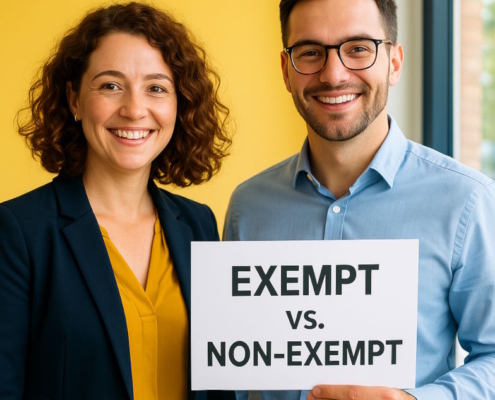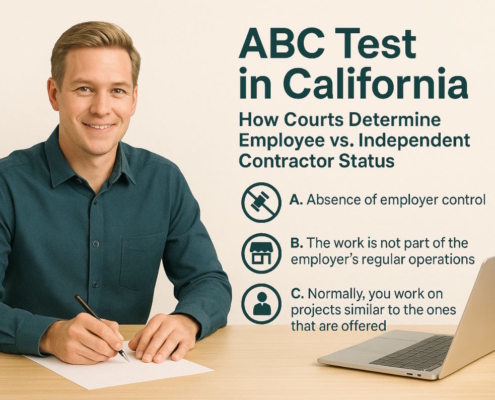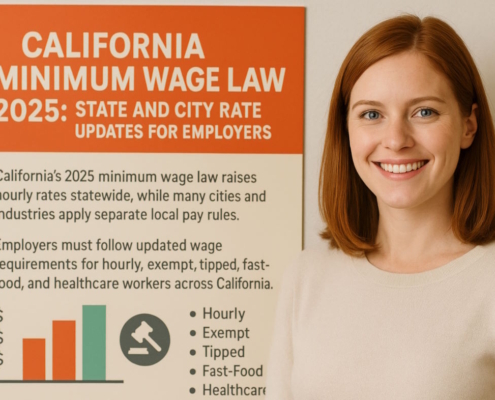How much sick time does California law give employees?
The Healthy Workplaces, Healthy Family Act of 2014 (HWHFA), as revised by SB 616, mandates that California employers offer paid sick leave to their employees.
The fundamental provisions of California’s paid sick leave statute are as follows:
- Workers who work 30 or more days in a 12-month period for the same employer are considered covered, regardless of whether they work full-time, part-time, temporarily, or seasonally.
- For every 30 hours worked, covered employees are required to accumulate at least one hour of sick leave. As long as they are legal, other accrual procedures can be considered.
- It is possible for an employer to restrict the amount of paid sick leave that an employee can take in a single year to a maximum of forty hours or five days.
- Employers are required to let employees carry over unused paid sick leave to the next year, up to a maximum of 80 hours (or 10 days). Carryover is possible even without a lump sum policy.
Step 1: Establish Coverage Needs
The paid sick leave statute applies to all companies with employees in California, with a few exceptions. Some groups of workers are exempt from the HWHFA’s protections: those who are part of certain qualifying collective bargaining agreements (CBAs), those who work for government entities as retired annuitants, some people who work for air carriers, and those who provide in-home supportive services (eligible for the IHSS Paid Sick Leave Program). Paid sick leave is an employee benefit under a CBA, but only for the reasons specified in the law.
In addition to California’s state legislation, there are a number of municipal sick leave policies, and these regulations sometimes diverge from the state’s mandates. For instance, hotel employees in Long Beach and Los Angeles are protected by paid leave statutes. If paid sick leave is required by law in the area where an employee works, the employer must research the specific regulations in that area to find out who is eligible, which workers are excluded, and any other discrepancies between the rules at the state and local levels.
Businesses operating in areas of California where sick leave regulations are in place, like Berkeley, Los Angeles, Emeryville, Oakland, San Diego, and others, are obligated to adhere to both the state and city regulations. If an employee who was already qualified for paid sick leave is hired again within a year, they can still earn and use sick leave.
Step 2: Adhere to Mandatory Posting in the Workplace
Companies are required by the Division of Labor Standards Enforcement to display the Paid Sick Leave Poster in a highly visible and easily readable area of the workplace. In addition to posting the sign in the office, employers in California that have employees working from home or other distant locations can also send them a copy.
Step 3: Establish Eligibility for Paid Sick Leave
There are a few different ways in which businesses may provide their workers paid sick leave:
- The method of statutory accrual: Starting on the first day of work, employees are eligible to accrue one hour of paid sick leave for every thirty hours worked. A worker who puts in 40 hours a week would, for instance, get 1.33 hours of sick pay every week.
- Other accrual mechanisms: Any other method of accrual that the employer chooses is acceptable so long as the accruals are regular and the employee has accrued at least 24 hours or three days of paid sick leave within 120 calendar days of the hire date, and 40 hours or five days of paid sick leave within 200 calendar days.
- All at once: At the start of each calendar year, employees have the option to receive a lump amount from their employers equal to forty hours of work or five days of sick leave. Within 120 days of their hiring date, new recruits must get 24 hours, or three days, of the lump payment. By the 200th day of work, they must have received the remaining 16 hours, or two days.
When determining the 12-month period, employers have the option to utilize an employee’s anniversary date, calendar year, or another period. On the anniversary of their employment date each year, for instance, a business can offer its workers lump sum paid sick leave equal to five days or forty hours.
- An already-in-place paid time off (PTO) policy: Any current paid leave program, whether it’s a combined PTO policy or separate banks for vacation and sick leave, is allowed so long as it meets the legal minimum and employees may utilize their paid leave for lawful purposes.
Other factors to think about
Every year, workers can roll over any unused vacation time they may have. However, companies can set a limit of 80 hours or 10 days of paid sick leave per employee. Carryover is possible even without a lump sum policy.
Unless the business paid out the unused leave when the employee was fired, the employer is required to restore all accumulated and unused paid sick days to the employee if they are rehired within one year of their separation.
Companies should think about whether it’s better to offer paid sick leave as part of a combined PTO plan or to have a separate policy for paid sick leave. Although it could be easier to just have the current PTO policy in place that meets the paid sick leave criteria, there are a few drawbacks to a combined PTO plan. For instance, it could be more tedious to monitor an employee’s sick leave usage if it’s open-ended. Furthermore, employers are not compelled to pay out sick leave hours that are explicitly intended for legally covered sick absences, but any unclaimed PTO hours must be paid out upon departure.
Step 4: Determine the Purpose of Paid Sick Leave
- Waiting time: While accrual of paid sick leave must begin immediately upon employment under legal requirements, employers have the option to impose a waiting time of up to 90 days before new recruits may use their earned sick leave. Note: Companies that offer a lump sum of paid sick leave have 120 calendar days from the date of hire to do so. This means that employees may not be able to use their “earned” time off until their 120th day of work.
- Use restrictions: Employers have the right to cap an employee’s paid sick leave at 40 hours a year, or five days, even though employees can accrue more than that. If an employee’s work schedule is not standard eight hours, the employer is required to provide them with a minimum of five days of vacation every year, or forty hours if that is greater.
A worker who puts in ten hours each day would be eligible for fifty hours of paid sick leave, which is five full days. On the other hand, a six-hour-a-day worker would only need 18 hours of paid sick leave to cover a three-day absence, leaving them with 22 hours of sick leave to spare.
- Cap on accruals: Another option is for employers to set a maximum accrual amount of 80 hours or 10 days, whichever is greater.
- Small increments: Although companies have the option to permit paid sick leave in smaller increments, employees are obligated to use it in no more than two-hour intervals.
- Reasons for taking time off: Many workers and their families need paid sick leave, and employers are required to provide it for several reasons:
- Checkups or diagnoses.
- Taking care of or treating a health problem.
- Victims of sexual assault, stalking, or domestic abuse may be eligible for certain services.
No employer has the authority to dictate how and when an employee can use his or her paid sick leave. Even if an employee does not give specific reasons for needing sick leave or cannot present a doctor’s note, their employer is still required to approve the use of paid sick leave.
- Includes covered family members: The following individuals are considered family members of an employee: their parents, parents-in-law, children, spouse, registered domestic partner, grandparents, great-grandparents, siblings, or designated individuals. The paid sick leave regulations in one city may not apply to another; for instance, workers in Emeryville are able to use their sick time to take care of their guide dog. Business owners need to follow the rules set down by their respective states and localities.
- Avoiding retaliation: It is against the law to punish workers who take advantage of paid sick leave. It is unacceptable for employers to penalize workers for using paid sick leave.
Step 5: Figure out the pay rate
Companies are required by law to compensate nonexempt workers for paid sick leave just as they would for any other work-related absences. The following options are available under the legislation to establish the employee’s rate of pay:
By dividing the entire non-overtime compensation by the total non-overtime hours worked, you can determine the normal, non-overtime rate of pay for the workweek in which the employee utilized paid sick leave.
Dividing the worker’s total pay over the last 90 days (not counting extra bonus pay) by the number of regular hours worked during the full pay periods of the last 90 days.
In the same way that employers pay other forms of paid leave, such as vacation time, exempt employees must also be compensated for paid sick leave absences.
Step 6: Inform Staff Members
Upon hiring, employers are required under the HWHFA to inform all nonexempt workers in writing about the availability of paid sick leave. To comply with this notification obligation, the California Wage Theft Protection Act notice has been updated to include details regarding paid sick leave.
Paycheck stubs or an additional document sent with paychecks are required to show employees’ available paid sick leave amounts.
Organizations are required by law to provide their employees with a paid sick leave policy that explains the program’s availability, any restrictions the employer may have on sick leave usage, and how to access and utilize it.
Step 7: Keep accurate records
For a minimum of three years, employers are required to document the total amount of paid sick leave they have granted to employees as well as the amount of sick leave each employee has actually used. Employers should keep track of paid sick leave time independently of other forms of leave in order to guarantee compliance.































